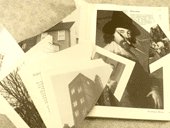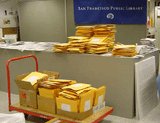
Vandalized book In early 2001, San Francisco Public Library staff began finding books hidden under shelving units throughout the Main Library. The books had been carved with a sharp instrument: covers and inner pages were slashed and odd almond-shaped pieces were cut out. As the mutilated books began accumulating, staff recognized that most of the volumes were related to issues of gay, lesbian, bisexual, or transgendered individuals, HIV/AIDS and women’s health issues. Staff members united to help find and inventory the over 600 damaged books, as well as to observe the stacks waiting for someone to shove damaged books under a shelf.
Eventually the vandal was caught by a librarian, on her day off, who alerted Library Security. The perpetrator was arrested, charged and found guilty of a hate crime. When the reports of the crime hit the newspapers, an outpouring of support as well as offers to help replace the volumes came from sympathizers across the country.
After the damaged books were returned by the San Francisco Police Department, most of them were determined to be beyond repair and would be withdrawn from the collection. The volumes were digitally documented, but it was felt that discarding the books would only complete the vandal’s crime.

Mailing damaged books Jim Van Buskirk, Program Manager for the Hormel Center, in conversation with local visual artists and Library staff initiated the process leading to the Reversing Vandalism project. A public call for participation was circulated offering the destroyed books to artists, community members and interested individuals. Response to the project was immediate and intense. People quickly understood that this vandalism was not solely about gay and lesbian issues or even about books, but represented a social climate increasingly filled with fear and hate. Participants from more than twenty states, as well as Japan and France, contributed work in a wide range of media: works on paper, sculpture, assemblage, textiles, paintings, photography, even a working clock.
Using found objects in art has a long and rich history. Cubist artists Pablo Picasso and George Braque are considered among the first modern artists to use collage, assemblage, and/or found objects in their work. Other international artists include Surrealists Max Ernst and Joan Miro, as well as the German artists Kurt Schwitters, Hannah Hoch and Joseph Beuys. Americans include Joseph Cornell, Robert Rauschenberg, Betye Saar and Jay DeFeo. Books, or pieces of them, figure into many contemporary artists’ work. “Altered books,” the genre in which books are used as a medium in creating artwork, continues to increase in popularity and importance.
The use of art in response to tragedy or hate has an equally impressive history. Artists have always known intuitively that creating a visual image through any medium can produce physical and emotional benefits for both the creator and those who view it. Some of these artists’ responses are whimsical, sad, angry or political. Many have created something beautiful from the shreds of a ruined book. Others added humor to the situation. Most impressive is the wide variety of responses. Using basically the same raw materials, artists have contributed an unexpectedly diverse range of expression as they participate in proselytizing the importance of reversing vandalism.

